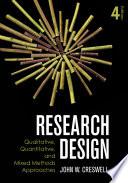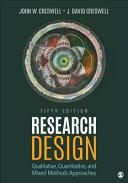
Research Design
Qualitative, Quantitative, and Mixed Methods Approaches
This edition for sale in USA and Canada only. The book that has helped more than 150,000 students and researchers prepare their plan or proposal for a scholarly journal article, dissertation or thesis has been revised and updated while maintaining all the features that made the first edition so popular. New to this edition: · Because mixed method research has come into its own since the publication of the first edition, every chapter now shows how to implement a mixed method design in your proposal or plan as well as showing how to do the other two (qualitative and quantitative) approaches · Ethical issues that may arise in quantitative, qualitative and mixed methods designs have been added to a new section in Chapter 3 · Writing tips and considerations have been expanded and moved to the first part of the book to get your research plan started in the right direction · The latest developments in qualitative inquiry, including advocacy, participatory, and emancipatory approaches have been added to Chapter 10 · Mixed Method Procedures (Chapter 11) show readers how to identify the type of mixed method strategy, select the data collection and analysis approaches, and plan the overall structure of the study Examples, drawn from various disciplinary fields, are used throughout the book to deepen the readers understanding of the discussion. These include examples of studies with marginalized individuals in our society that reflect issues in social justice in addition to the traditional samples and populations studied by social researchers.
- ISBN 13 : 1452226091
- ISBN 10 : 9781452226095
- Judul : Research Design
- Sub Judul : Qualitative, Quantitative, and Mixed Methods Approaches
- Pengarang : John W. Creswell,
- Kategori : Social Science
- Penerbit : SAGE
- Bahasa : en
- Tahun : 2014
- Halaman : 305
- Google Book : http://books.google.co.id/books?id=PViMtOnJ1LcC&dq=intitle:Qualitative+Research+Methodology&hl=&source=gbs_api
-
Ketersediaan :
012481 Tersedia di Library of UI BBC
This edition for sale in USA and Canada only.









